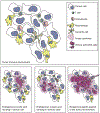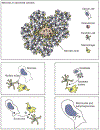Activating the Nucleic Acid-Sensing Machinery for Anticancer Immunity
- PMID: 30798988
- PMCID: PMC6754183
- DOI: 10.1016/bs.ircmb.2018.08.006
Activating the Nucleic Acid-Sensing Machinery for Anticancer Immunity
Abstract
Nucleic acid sensing pathways have likely evolved as part of a broad pathogen sensing strategy intended to discriminate infectious agents and initiate appropriate innate and adaptive controls. However, in the absence of infectious agents, nucleic acid sensing pathways have been shown to play positive and negative roles in regulating tumorigenesis, tumor progression and metastatic spread. Understanding the normal biology behind these pathways and how they are regulated in malignant cells and in the tumor immune environment can help us devise strategies to exploit nucleic acid sensing to manipulate anti-cancer immunity.
Keywords: Cancer; Innate immunity; RIG-I; STING; TLR; Tumor; Vaccine.
© 2019 Elsevier Inc. All rights reserved.
Figures




References
-
- A-GONZALEZ N, BENSINGER SJ, HONG C, BECEIRO S, BRADLEY MN, ZELCER N, DENIZ J, RAMIREZ C, DIAZ M, GALLARDO G, DE GALARRETA CR, SALAZAR J, LOPEZ F, EDWARDS P, PARKS J, ANDUJAR M, TONTONOZ P & CASTRILLO A 2009. Apoptotic cells promote their own clearance and immune tolerance through activation of the nuclear receptor LXR. Immunity, 31, 245–58. - PMC - PubMed
-
- ABLASSER A, HEMMERLING I, SCHMID-BURGK JL, BEHRENDT R, ROERS A & HORNUNG V 2014. TREX1 deficiency triggers cell-autonomous immunity in a cGAS-dependent manner. J Immunol, 192, 5993–7. - PubMed
-
- ABUODEH Y, VENKAT P & KIM S 2015. Systematic review of case reports on the abscopal effect. Curr Probl Cancer. - PubMed
Publication types
MeSH terms
Substances
Grants and funding
LinkOut - more resources
Full Text Sources
Research Materials

